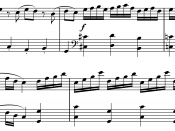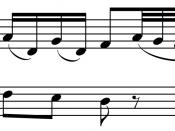Symphonies required more variety and flexibility of sound than anything orchestras of the early 18th century could provide. There are four movements in the symphony. The first opening movement of a symphony is a substantial piece in fast tempo and in sonata form. Sometimes this fast music is preceded by a short but solemn introduction in a slower tempo. The second movement strikes a contrast with the first by its slow tempo and quiet mood. The third movement contrasts by its persistent dance rhythms and it is always a minuet and trio. A minuet is a moderately paced dance in triple meter. The fourth movement is faster, faster than the first and can be in sonata form like the first movement. The sequence is basically from fast/complex to slow/quiet to fast/brilliant. A musical example is "Symphony in G Minor" by Mozart. Also, the sonata is closely associated with the symphony.
The opening movement of every symphony is in sonata form, and this movement counts as the intellectual and emotion core of the whole work. Sonata form exploited what was the overriding interest of Classical composers. Composers found sonata form particularly rich and flexible in its expressive application. It was something they could use for forceful brilliant, pathetic, even tragic opening movements, gentle or dreamy slow movements, and lively, often humorous closing movements. Sonata form is a large-scale example of A B A' form, usually with repetitions. A is the exposition, B is the development and A' is the recapitulation. Ranging from the dynamics, tempo to tone color, the sonata form is an important manifestation of the Classical Era. In the Exposition there are two themes present which contrast in dynamics melody and rhythm. There is also a bridge which is a change in key or modulation. The Development incorporates a tonal thematic tension with contrasting themes and keys of the exposition. Finally, the Recapitulation is the real sense or relief or resolution with the first theme present followed by other themes. The music now remains in the same key, the tonic key. The terms of the sonata form resemble those use in discussions of drama. Indeed, sonata has a dramatic quality like the themes seem almost like characters in a play or a novel to whom things are happening. They seem to change, take part in various actions and react to other themes and musical processes.





